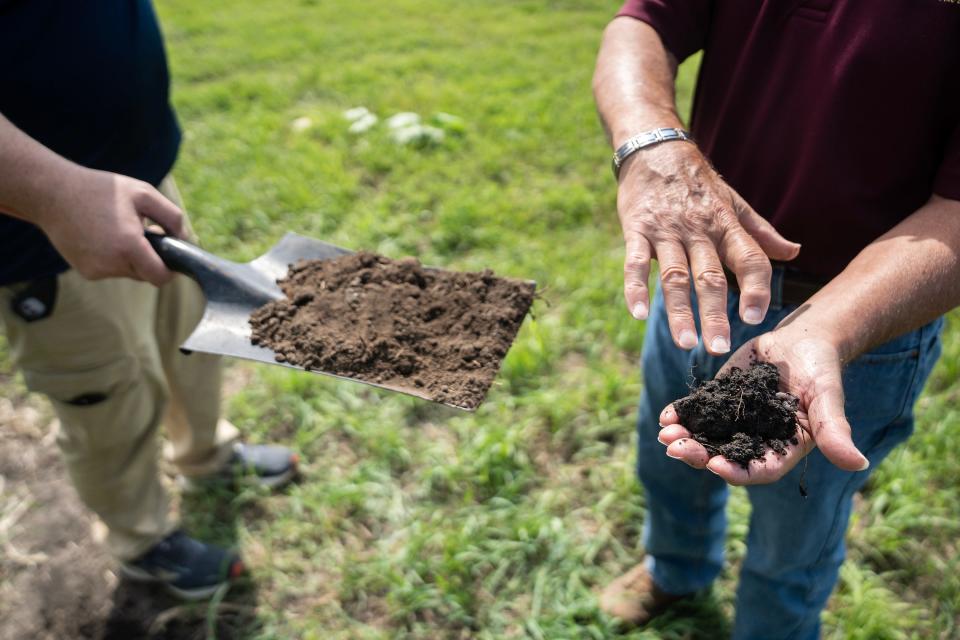For farmers to reap billions in subsidies, they must do their part to protect soil health
This newspaper, opening a 2005 investigation into farmland ownership, wrote this: “In Iowa, we’ve always been able to take for granted that the land will provide.”
But Donnelle Eller’s exclusive Sept. 13 story, about research on the condition of Iowa’s soil, put numbers to an easy-to-forget fact: That soil is not, in fact, an eternal resource.
Iowa once had 96 billion tons of soil organic carbon, but half or more of it is gone, extracted in various ways over just four generations by intensive farming, according to data from a group studying soil carbon in the Midwest. That organic material is what distinguishes Iowa as one of the best places on Earth to grow crops.
While it might be hard to get our heads around “96 billion tons” and what that looks like spread over the state’s 56,000 square miles, “half” is a concept we all can grasp. The researchers are straightforward about another thing, too: Many conventional farming practices contribute significantly to the carbon loss. And further, established conservation-oriented approaches demonstrably help to preserve soil carbon.

This data adds to other arguments for adopting no till farming, going heavy on cover crops in all seasons, and sometimes idling land. Those practices help to curb erosion, which is important not just to retain healthy soil but also to prevent fertilizer from further fouling Iowa water. Recognizing this, the federal government and other entities have created numerous programs to encourage more farmers to try.
The trouble is that it mostly stops at encouragement. Paying property owners to idle some land, for example, is well and good, but years and years of experience have shown that rewards alone are not enough to make big changes in agriculture habits.
The federal farm bill is due for its every-five-years reauthorization. Members of Congress said they wouldn't finish negotiating before the fiscal year ended on Sept. 30 and that current programs would need to be temporarily extended. During the extra time, negotiators need to be talking about how to adapt government-run conservation and other programs in a way that increases adoption. Another factor adding to the urgency: Climate change threatens more frequent, severe rain and windstorms, research shows, making protection of our soil all the more urgent.
The government has leverage. The Environmental Working Group says that crop insurance payouts and subsidized premiums totaled over $240 billion from 1995 to 2020. It’s true that keeping farmers whole through crop insurance is rooted at least in part in recognizing the importance of raising food, and the capricious destruction the weather can wreak. But we can respect that principle while still expecting more from growers who accept those billions.
This doesn’t mean inflicting ruin on farmers through regulation. Some farmers noted to Eller that they don’t sacrifice financial viability or yields by farming in a more sustainable way.
Payment of insurance and other subsidies must be connected to farmers doing their work in a way that respects soil and water instead of treating it as a resource to be pillaged. That’s a principle that can guide farm bill talks, even while recognizing the difficulties in quantifying such farm practices and recognizing that production agriculture is a behemoth whose direction won’t be turned on a dime.
More: Iowa's legendary soil, the bedrock of its economy, is losing its richness, new research shows
The work that scientists shared with the Register is immensely complicated. Measuring soil organic carbon is not like reading a fuel gauge, and it is difficult to isolate all the variables at work with soil and climate and technology advances.
Data is still being collected to try to determine best practices. But the scientists who have spent years trying to bring clarity to this subject know enough – about the stakes, and about what steps can make a difference – for Congress to act.
— Lucas Grundmeier, on behalf of the Register’s editorial board
ANOTHER VIEW: How carbon farming combats climate change
FURTHER READING: Only 50 years of farming left if soil degradation continues
FURTHER READING: Soil: Grounding us in transformative systemic change
This editorial is the opinion of the Des Moines Register's editorial board: Carol Hunter, executive editor; Lucas Grundmeier, opinion editor; and Richard Doak and Rox Laird, editorial board members.
Want more opinions? Read other perspectives with our free newsletter, follow us on Facebook or visit us at DesMoinesRegister.com/opinion. Respond to any opinion by submitting a Letter to the Editor at DesMoinesRegister.com/letters.
This article originally appeared on Des Moines Register: For America's farmers to get subsidies, they must protect soil health

